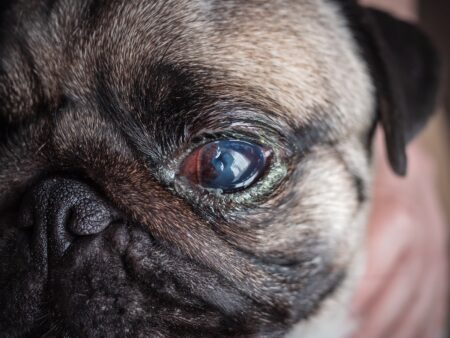
Keratoconjunctivitis sicca (KCS) is the medical term for dry eye.
Causes of KCS
Dry eye in pets is commonly caused by an immune-mediated inflammation of the tear glands. Chronic inflammation damages the gland and causes decreased production of the essential watery component of tears. Tears play an important role in maintaining the health of the ocular surface, protecting the eye from infection and irritants.
KCS is a very common canine eye disease with a reported incidence of 1% to 2% of dogs in North America. By contrast, the incidence of dry eye in cats is very low. The disease most likely has a genetic component, as it is more prevalent in some breeds including the Cocker spaniel, English bulldog, Lhasa Apso, Shih Tzu, West Highland White Terrier, Schnauzer, Pug, Cavalier King Charles Spaniel, among others. Dogs that have a history of a prolapsed gland of the third eyelid (cherry eye) may also be pre-disposed to dry eye.

Clinical Signs of KCS
When there is a decrease in tear production, drying and inflammation of the surface tissues of the eye occur. The conjunctiva and cornea become red and inflamed. Thick yellow to green ocular discharge may build up around the eye. Secondary corneal ulceration commonly occurs. The cornea may become pigmented and scarred from chronic inflammation. Brachycephalic dogs with large protruding eyes, including pugs or bull dogs, may be more severely impacted by the disease.
Common Symptoms of Dry Eye

Squinting or holding the eyes closed
- Rubbing the face and eyes
- Red or inflamed eyes
- Thick goopy ocular discharge near the eyelids
- Corneas appear dull and dry
- Secondary conjunctivitis, infections, or ulcers
- Dark pigment on the eye surface
- Prominent blood vessels on the eyes
Diagnosis of KCS
KCS may tentatively be suspected based on history and clinical signs. On physical exam a veterinarian may find thick ocular discharge, a cornea that appears dry or ulcerated, and corneal pigmentation.
KCS diagnosis is confirmed by measurement of tear production using the Schirmer tear test. Dogs that produce less than 10mm of tears over a minute on a Schirmer tear test have insufficient tear production and are likely suffering from KCS. The tear test may be performed on more than one occasion, because the results can vary somewhat. Other causes of conjunctivitis, keratitis, and thick discharge are ruled out with a thorough eye examination.
Treatment of KCS
The main goal of treatment is to control immune-mediated KCS by stimulating natural production of the tear film’s aqueous component. Topical cyclosporine or tacrolimus are the cornerstone of KCS immunomodulating therapy.
Cyclosporine is FDA approved and commercially available as an ointment. An additional medication, Tacrolimus, is available as a treatment from compounding pharmacies. Either of these drugs is administered 1-3 times daily, often life long. Tear production may increase within 3-4 weeks, but it can take as long as 12 weeks to see a response.

In addition to immunomodulators, keeping the eyes well lubricated protects the cornea and increases patient comfort. A variety of products, such as Optixcare eye lube, are available for animal eyes. Topical antibiotics such as Neo/Poly/Bac ointment may also be administered to treat secondary corneal ulcers, infections, and conjunctivitis.

Prognosis of KCS
KCS is a lifelong and chronic disease that may be controllable but is not curable. Regular diligent administration of eye medications by the pet owner and follow-up progress exams with a your veterinarian are key to managing dry eye. Eyes that respond to tear stimulant medications have a good prognosis. Medications need to be administered daily, response to therapy monitored, and treatment adjustments made to maintain the health and comfort of the eye.
Unfortunately, some KCS patients may have a guarded or poor prognosis. Not all patients respond to the available medications. Some patients may need referral to a veterinary ophthalmologist and numerous medications used to manage their dry eye. If untreated, KCS has a poor prognosis. Untreated dry eye can cause chronic pain, compromise a pet’s quality of life, and may cause permanent damage to eyesight.






Recent Comments